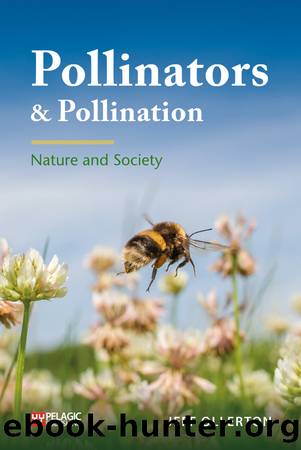Pollinators & Pollination by Jeff Ollerton

Author:Jeff Ollerton
Language: eng
Format: epub
Publisher: Pelagic Publishing
Published: 2021-05-15T00:00:00+00:00
FIGURE 9.4 A gatekeeper (Pyronia tithonus) taking nectar from flowers of a dark form of buddleia (Buddleja davidii var.).
As well as the larval food plants required by gatekeepers, thereâs a range of nectar sources available in a mixed native/introduced hedge along the northwest boundary of our garden. These include bramble (Rubus fruticosus agg.) and oval-leafed privet (Ligustrum ovalifolium), and the butterflies particularly love the dark, heavily scented inflorescences of the buddleia (Buddleja davidii var.) seen in Figure 9.4. Only one of these (the bramble) can be considered native to Britain; both the privet and the buddleia originated in Asia.
The final species I want to mention is the beautiful cinnabar moth (Tyria jacobaeae), the larvae of which feed on ragworts (Senecio spp. and Jacobaea spp. â Asteraceae). We allow a small patch of J. vulgaris (which most people know by its old name of S. jacobaea) to grow and flower in the lawn. Most years there are cinnabar larvae feeding on them, vivid yellow and black caterpillars whose colours warn predators of their toxicity. The adults are even more spectacular (Figure 9.5) and an interesting example of convergent evolution with the similarly striking six-spot burnet moth (Zygaena filipendulae â see Figure 2.2).
Download
This site does not store any files on its server. We only index and link to content provided by other sites. Please contact the content providers to delete copyright contents if any and email us, we'll remove relevant links or contents immediately.
| Automotive | Engineering |
| Transportation |
Whiskies Galore by Ian Buxton(40329)
Introduction to Aircraft Design (Cambridge Aerospace Series) by John P. Fielding(32338)
Small Unmanned Fixed-wing Aircraft Design by Andrew J. Keane Andras Sobester James P. Scanlan & András Sóbester & James P. Scanlan(32141)
Craft Beer for the Homebrewer by Michael Agnew(17445)
Turbulence by E. J. Noyes(7037)
The Complete Stick Figure Physics Tutorials by Allen Sarah(6638)
Kaplan MCAT General Chemistry Review by Kaplan(6053)
The Thirst by Nesbo Jo(5785)
Bad Blood by John Carreyrou(5768)
Learning SQL by Alan Beaulieu(5411)
Weapons of Math Destruction by Cathy O'Neil(5036)
Man-made Catastrophes and Risk Information Concealment by Dmitry Chernov & Didier Sornette(4735)
iGen by Jean M. Twenge(4702)
Digital Minimalism by Cal Newport;(4540)
Life 3.0: Being Human in the Age of Artificial Intelligence by Tegmark Max(4507)
Audition by Ryu Murakami(4098)
1,001 ASVAB Practice Questions For Dummies by Powers Rod(4038)
Electronic Devices & Circuits by Jacob Millman & Christos C. Halkias(4027)
Pale Blue Dot by Carl Sagan(4001)
